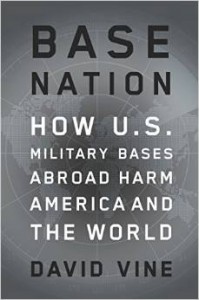
David Vine
Fundamental Work, Narrow, Understates Total True Cost
This is a five-star academic work, a superb up-to-date compilation of what can be known legally and ethically about US military bases in all forms from the formal to the undeclared and covert, around the world. It's inclusion in the American Empire Project puts the author in the company of such great scholars and iconoclastic observers as Andrew Bacevich, Noam Chomsky, Robert Dreyfuss, Chalmers Johnson, and Howard Zinn.
The author provides a compelling combination of history, anthropological-sociological narrative, and political-economic calculation as to the cost of what some estimate to be as many at 1,000 bases around the world.
The references are a fine mix of books, articles, online sources, and as a good a range of Government Accountability Office (GAO), Congressional Research Service (CRS), and other limited edition publications including PhD theses.
I find multiple bottom lines in this book that could but does not go far enough, but is certainly an excellent starting point for getting to a total true cost that I believe is at least five times the author's calculation of $170 billion a year and that is only in relation to total cost in dollars — if the cost of environmental pollution, geoengineering, false flag terrorism, and everything else is added up, the overseas bases that enable our “secret teams” and our not so secret occupying forces are the base of a multi-trillion dollar criminal industry that leaves no country untouched.
01 Drawing on RAND and former senior Department of Defense leaders, the author shows how any given base overseas costs at least twice what it would cost, per year, if it were located in the USA
02 The effectiveness costs of destroying the military's ability to do its own logistics including combat and support engineering, in favor of private military corporations (PMC).
03 The internal social costs of a constantly deployed military include truly horrific internal rapes — not just men of women but men of men — and an aggregation of pathologies that I find worthy of an immediate shut-down.
04 The external social costs of this same deployed military are huge — from entire cities devoted to prostitution around the largest of US base networks (Korea and Germany stand out) to criminal relationships carried over from one command to the next. External costs also include inflated land prices, distortions in local and national government spending (e.g. granting land and waivers to US forces in lieu of pursuing the public interest).
05 The opportunity costs to American society of misdirected spending on the military are very well covered by the author, and merit careful study. These opportunity costs span both the alternatives in the way of poverty remediation, expenditures on domestic infrastructure, education, and family services, health care, are more; spending by troops and the military within the US domestic economy instead of foreign economies; and tax avoidance by the PMCs.
06 The outright waste cost of a system that is out of control — the military simply does not do cost-benefit analysis and — my own comment here, has no strategy because it lacks intelligence with integrity.
07 The total cost of Empire — the vast costs, including the four trillion dollar war that destabilized Iraq and and began the unraveling of the Middle East, Central Asia, and North Africa. The author offers less in this area than I would have liked as context, but his focus is on bases and their direct costs.
In addition to this book, below are five books the author has drawn on that I find noteworthy, followed by five books I consider helpful to understanding the criminally irresponsible overseas presence of the US military — as I am publishing in CounterPunch today, our National Military Strategy is nothing more than dishonest platitudes — we have a hollow military spread too thin, a military that cannot win wars. The time has come to close all of our overseas bases without exception, and to bring our forces home while we retrench, eradicating 30% of the budget known to be waste (which is actually 50%, but we start with 30%), while creating a 450 ship distributed Navy, an air-mobile Army, and a long-haul Air Force, all based firmly at home.
Author Resources
2009 Lutz, Catherine. The Bases of Empire: The Global Struggle Against U.S. Military Posts
2004 Baker, Anni. America Soldiers Overseas: The Global Military Presence
1963 Stambuk, George. American Military Forces Abroad: Their Impact on the Western State System
Contextual Recommendations
2006 Dreyfuss, Robert. Devil's Game: How the United States Helped Unleash Fundamentalist Islam
2004 Johnson,Chalmers. The Sorrows of Empire: Militarism, Secrecy, and the End of the Republic
2003 Butler, Smedley. War is a Racket: The Antiwar Classic by America's Most Decorated Soldier
2003 Leebaert, Derek. The Fifty-Year Wound: How America's Cold War Victory Has Shaped Our World
The book has an index which will be a valuable aid to professionals. It could be slightly improved in its next printing by adding a bibliography and an itemized listing of bases with their costs and numbers sorted by country, but there are a number of good offerings online, inclusive of color maps (for example, there are 44 US bases surrounding Iran), so perhaps this is not that great a lack.



